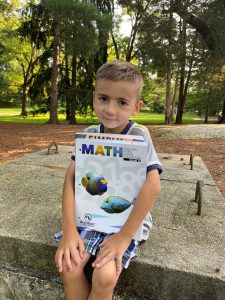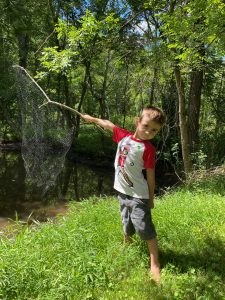A ‘Miracle’: Spinraza Gives Boy, Now 5, a Chance to Grow Up
Written by |

Jase on his first day of kindergarten. (Photo courtesy of Yoder family)
It’s now been more than four years since Spinraza (nusinersen) was first approved by the U.S. Food and Drug Administration, and presymptomatic children with spinal muscular atrophy (SMA) who received the therapy as part of the Phase 2 NURTURE trial are growing up fast and, by all accounts, showing good progress.
Jase Yoder, 5, is one of those children. He was featured as part of “The Gene” documentary on PBS last year. In the segment, Jase, who has SMA type 1, can be seen jumping on a trampoline.
Sitting up, walking, and jumping were all milestones Jase would have likely not achieved if it weren’t for Spinraza infusions. In fact, children with SMA type 1 typically don’t make it past the age of 2.
At 5 years old, Jase has taken up basketball, shooting three-pointers from the family’s garage. While Jase hasn’t quite yet mastered his shooting form, he still likes to show off to his mom. When he caught her walking through the garage recently, he asked her to watch and, after a few attempts, was able to sink a shot. This ability wouldn’t have been thought possible for a child of his age with SMA five years ago.
“He finally made a swish,” said Cheryl Yoder, 39. “And we celebrated.”
Since Jase started the NURTURE trial (NCT02386553) in 2015, Spinraza, developed by Biogen, has been approved, along with two other disease-modifying therapies. Novartis’ gene therapy Zolgensma was approved in 2019, and Evrysdi (risdiplam), developed by Roche and Genentech, followed in August 2020. This is remarkable progress for a disease that, prior to Spinraza’s approval in 2016, relied primarily on supportive care and symptomatic treatment.
Spinraza requires a spinal infusion three times per year, whereas Zolgensma is a one-time intravenous (into-the-vein) injection and Evrysdi is the first daily oral therapy for the disease.
Biogen continues to evaluate Spinraza in different contexts in ongoing studies. The Phase 2/3 DEVOTE trial (NCT04089566) is testing the potential benefits of a higher dose of the therapy. SMA patients are now being enrolled into Part B of that trial.
The company also launched a Phase 4 trial called RESPOND (NCT04488133), which is evaluating Spinraza’s effects in patients who did not have an adequate response to Zolgensma.
Biogen also is looking into neurofilament proteins, which might be used as a tool to demonstrate whether there is ongoing disease activity in SMA patients.
New data from the Phase 2 EMBRACE trial (NCT02462759) shows promising results in a broad range of SMA patients. According to the results, motor function levels of the 14 patients on Spinraza were significantly higher, at 93%, than those of the seven participants who received a sham treatment, whose levels were at 29%.
Jase is at the forefront of genetic science. He has now been involved in the NURTURE trial for nearly five years. All 25 children in the trial have survived, and 96% of them can walk with assistance, according to data released in June, which was accompanied by the announcement that the trial would be extended by another three years.
Getting Jase into the trial to begin with was somewhat of a miracle and another reason to celebrate. He was born in July 2015, and within a matter of weeks, his neurologist had recommended the family fly out to Chicago to get screened for the trial.
Yoder and her husband, Jeremy, 40, had found out their son had SMA eight days after he was born. They had initially avoided a follow-up with their neurologist because they didn’t know anything about available trials. It would probably be a conversation about hospice care, they figured. Plus, Yoder was exhausted and “in a baby cave,” she said in a phone interview with SMA News Today.
It turned out, however, that their doctor was in the process of becoming an investigator for the NURTURE trial and recommended they try to enroll Jase, since he wasn’t yet exhibiting any SMA symptoms. Two days after that appointment, the family was in Chicago, where Jase received his first spinal infusion, just 18 days after diagnosis. Now they go to their local neurologist every four months for a follow-up and injection and will continue to do so until Jase is 8.
These normal life activities take on new meaning for the Yoders, who lost their first daughter, Ariel, to SMA when she was an infant. Every so often, these moments stop either Yoder or her husband in their tracks.
“We started experiencing the delight that comes from just realizing he’s doing things that children with this diagnosis have never done before,” Yoder said. “It truly is to us a miracle and you don’t want to lose the wonder of that.”
Jase now has also transitioned to riding a bike with pedals, which he named Bolt. Another of his favorite activities is shooting his child-size compound bow. He now has enough strength to completely pull the string back. Before the family moved to Delaware, they lived in Baltimore, where there was an abundance of squirrels. Jase would get up at the break of dawn and stalk his prey. After many attempts, he scored his first kill, which, according to Yoder, “was a matter of great pride.”
Yoder has four other children, two older and one younger than Jase, and recently found out she has a fifth on the way. That brought apprehension but not the same level of anxiousness as when Jase was born following Ariel’s death. The new baby has a 25% chance of getting SMA.
“There’s Jase in the midst of us, and it somehow takes away some of the angst that I felt — just knowing that there’s treatments available and actually being able to experience how well it’s working,” Yoder said.
Children are not the only patient population benefiting from the groundbreaking treatment. According to Wildon Farwell, MD, global medical head of neuromuscular diseases at Biogen, 11,000 infants, children, and adults are now on Spinraza.
Spinraza has given hope for a better future to Thomas Broadhurst, an adult SMA patient 41 years older than Jase. When Broadhurst was diagnosed at age 15 with SMA type 3, doctors asked him to rest his muscles and quit sports. He had his own ideas though. Broadhurst played sports through high school and continues to lift weights to this day when he isn’t working as a performance and health psychologist.
Genetic tests revealed that Broadhurst had four healthy copies of the SMN2 gene, making the progression of his disease less severe. Even so, he uses a cane to help with balance, and if he isn’t careful, he can trip over obstructions on the ground and fall.
Only nine months into his treatment, Broadhurst has noticed his endurance and recovery levels have improved and the frequency of falls has decreased. He says he feels like he has “more good days than bad days.” Broadhurst also has seen a benefit in his mental health and future outlook, knowing there might be better days ahead.
“It’s really helped because it’s done a lot to kind of fan that flame of hope,” he said in a phone interview with SMA News Today. “We all need to have that piece of faith and we all need to have that lifeline to grab onto.”
Feedback from patients like Jase and Broadhurst has been positive, thanks to the nature of the treatment, Farwell said. A spinal tap delivers the drug to cells that need it most, and targeted machinery behind the treatment, which forces the SMN2 gene to produce a functional SMN protein, have yielded good results, he explained.
While Jase is doing well, SMA has still affected his strength. He works with his physical therapist on balancing exercises so his weakened muscles won’t give up on him. Yoder says that, while he’s not on the “strong end of the spectrum,” he’s not so weak that he can’t play with his brothers. The verdict is still out on how children dosed with Spinraza might develop into adolescence and adulthood.
“We’re just on the front end of finding out what it’s going to be like and that’s OK,” Yoder said. “I just have to remind myself that really, all of us don’t know what life is going to hold.”









